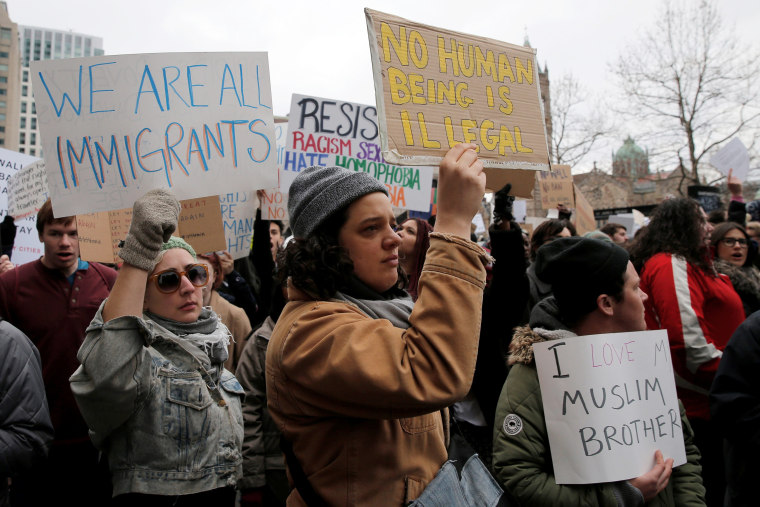Take two.
President Trump on Monday signed a revised version of his controversial executive order on immigration, excluding Iraq from the list of certain predominantly-Muslim countries whose citizens face temporary bans.
The new order will go into effect on March 16 as the White House tries to make sure "the courts don't have grounds for pushback," a senior administration official told NBC News. The original order triggered international disruptions and sparked protests before being blocked in federal court.
Trump signed the new order behind closed doors around 11:30 a.m. while Secretary of State Rex Tillerson, Homeland Security Secretary John Kelly and Attorney General Jeff Sessions unveiled it in front of reporters. Tillerson stressed there would be "coordination" between federal agencies on the new decree, breaking from what critics saw as a hasty and disorganized roll-out for the original order.
Here's what you need to know about the new EO, which potentially reignites one of the most contentious debates of Trump's young presidency.
What's different this time?
— The new executive order removes Iraq from the list of predominantly-Muslim countries whose citizens will face a 90-day ban on travel to the United States. (The Pentagon and the State Department had reportedly pressed the White House to keep Iraq, an important ally in the battle against ISIS, off the list. A fact sheet released by the White House says Iraq agreed to "increase cooperation with the U.S. government on the vetting of its citizens.")
But the revised order keeps the temporary ban on citizens of Iran, Somalia, Sudan, Yemen, Syria and Libya who are seeking new visas. The order exempts people who already have valid visas or U.S. green cards.
— The revised order temporarily halts all refugee admissions to the U.S. (excluding refugees who are already formally slated to travel by the State Department) and removes extra restrictions on Syrian refugees. Syrian refugees will now be treated like refugees from other countries and be subjected to a 120-day suspension of the refugee program. The new order also scraps a loophole for "persecuted religious minorities," language that critics had pounced on to prove the White House was giving preferential treatment to Christians while barring Muslims. When the refugee program restarts, the total number allowed into the U.S. will be limited to 50,000 for fiscal year 2017.
— Unlike the first go-round, the new order won't take effect immediately. It takes hold on March 16, ten days from the signing. This is a notable shift for the president, who on Jan. 30 had derided giving foreign travelers "one week notice" on the original order:
What's the status of the original EO?
It's been on hold. A federal judge in Seattle issued a nationwide temporary restraining order on Feb. 3, and a three-judge panel from the 9th U.S. Circuit Court of Appeals on Feb. 9 refused a Justice Department request for a stay on that decision, effectively blocking the travel ban. NBC News reported in early February that White House lawyers were working on a rewrite of the EO that could pass legal muster. Here's a timeline of what's happened since then.
Will the new EO be controversial?
Almost certainly.
The initial EO, signed by Trump on Jan. 27, triggered panic at airports nationwide as green card holders, students, professors and other travelers from the countries in question were detained and blocked from entering the U.S. The ensuing legal battle and public outcry consumed the early weeks of Trump's presidency.
Critics accused the Trump administration of orchestrating an unconstitutional "Muslim ban." Trump has insisted the EO was no such thing, saying in a statement in January that "this is not about religion." (That said, then-candidate Trump had called for a "total and complete shutdown of Muslims entering the United States" in December 2015.)
The White House has said the ultimate goal of the order is to keep would-be terrorists out of the U.S. while the government assesses the vetting system for refugees and visa applicants from certain parts of the world.


